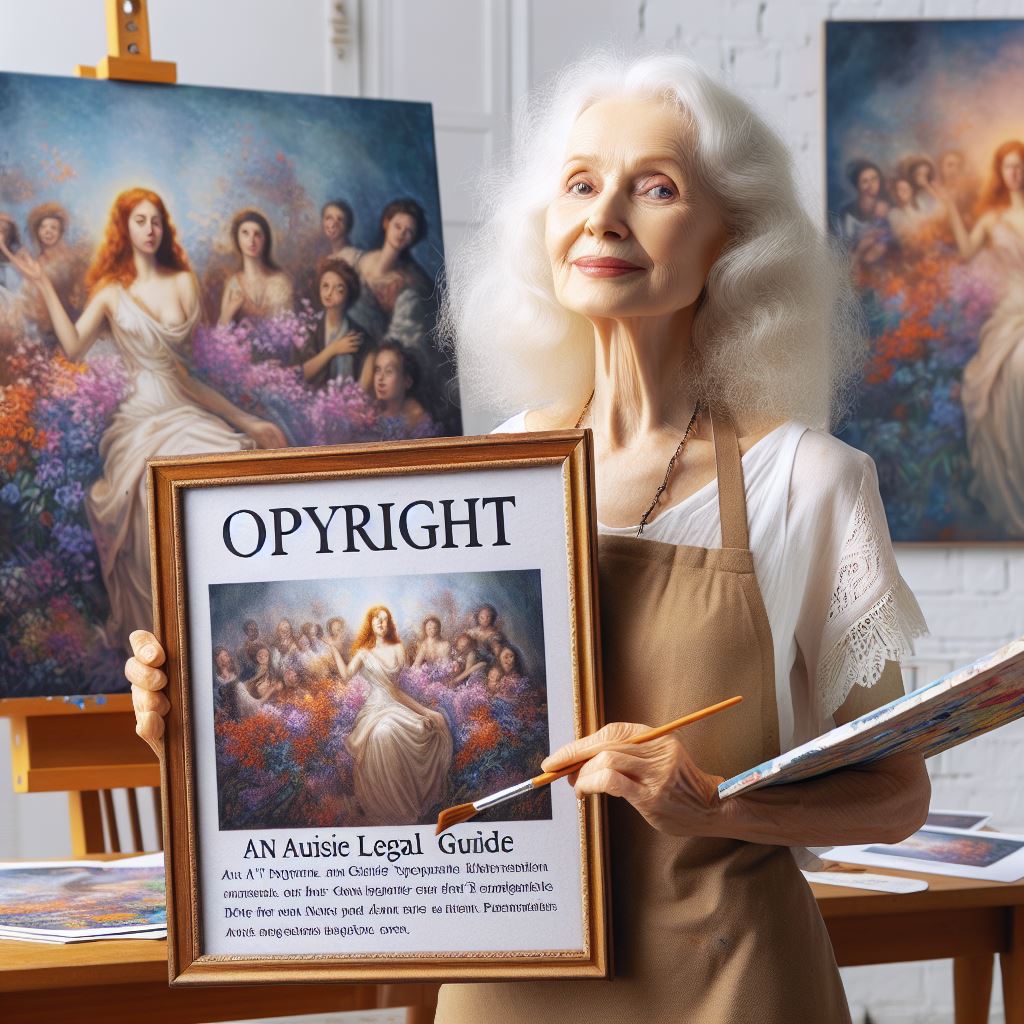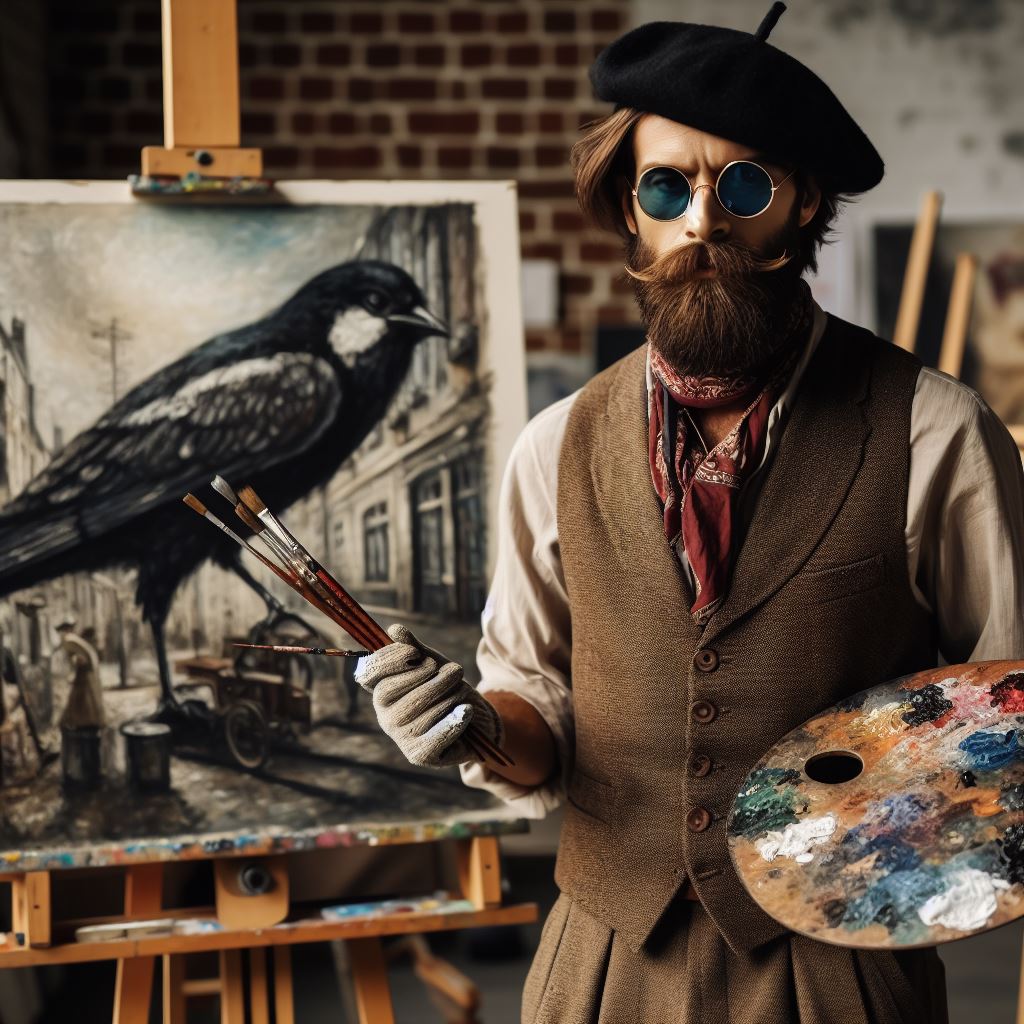Introduction
Understanding artists’ rights is crucial for both artists and the public. The Australian legal framework provides protection and support for artists’ rights.
Artists’ rights are essential for the growth and development of the artistic community.
They secure artists’ control over their work and ensure fair compensation for their creative endeavors.
Understanding these rights is vital for both artists and the general public.
Australia has a well-established and comprehensive legal framework that supports and protects the rights of artists.
It encompasses various laws and regulations that aim to protect artists and their creations.
This framework provides a strong foundation for artists to exercise their rights and assert their ownership over their work.
Copyright law is a significant component of artists’ rights.
It grants creators exclusive rights to reproduce, distribute, and publicly display their work.
This empowers artists to control the use of their creations and facilitates earning income from their art.
Additionally, moral rights protect the integrity and reputation of artists.
Artists assert the right to recognition as creators and to prevent any derogatory treatment or distortion of their art.
These rights uphold the integrity of the artistic community and allow artists to maintain control over the presentation and message of their creations.
Understanding artists’ rights empowers artists to assert their legal protections and navigate the complexities of the art industry.
It also provides the public with awareness of the importance of supporting and respecting artists’ rights.
By appreciating and valuing artists’ rights, we contribute to the thriving cultural landscape of Australia and ensure a sustainable future for artistic endeavors.
Overview of Copyright Law
Definition of copyright and its purpose
- Copyright is the legal protection granted to original creative expressions.
- Its purpose is to ensure that artists have exclusive rights to their creations.
Copyright protection for artistic works in Australia
- In Australia, copyright protection applies to various artistic works.
- These include paintings, sculptures, photographs, architecture, and graphic designs.
- This protection also extends to literary, musical, and dramatic works.
Duration and scope of copyright protection
- Copyright protection in Australia typically lasts for the life of the artist plus 70 years.
- This extended duration ensures that artists and their heirs have long-term exclusive rights.
- The scope of protection covers reproduction, adaptation, publication, and communication to the public.
Rights granted to copyright owners
- Copyright owners have the exclusive right to reproduce and distribute their artistic works.
- They can also prevent others from reproducing, adapting, or communicating their works without permission.
- This includes the right to sell, rent, or lend their works to the public.
- If anyone infringes on these rights, copyright owners can take legal action.
Overall, copyright law is essential for protecting the rights of artists and ensuring the continued development of the arts industry in Australia.
Read: Melbourne’s Literary Scene: A Guide
Moral Rights
Definition and purpose of moral rights
- Moral rights refer to the personal and non-economic rights of artists to protect the integrity and attribution of their works.
- The purpose of moral rights is to safeguard the reputation and integrity of artists and their creations.
Types of moral rights: right of attribution, right against false attribution, and right of integrity
- The right of attribution grants artists the authority to be recognized as the creator of their works.
- The right against false attribution prevents others from falsely claiming authorship of an artist’s work.
- The right of integrity ensures that artists have control over any modifications or alterations made to their works.
Duration and protection of moral rights
- Moral rights typically persist even after an artist has sold or transferred the copyright of their work.
- These rights endure for the duration of the artist’s lifetime and are inheritable after their death.
Limitations on moral rights
- Moral rights can be limited when they conflict with the rights of others or certain public interests.
- For example, if displaying an artwork in a public space requires modifications, the right of integrity may be limited.
- However, these limitations must be reasonable and should not unduly harm the artist’s reputation or the work’s integrity.
Moral rights constitute a crucial element of an artist’s legal protection, safeguarding their artistic vision and reputation.
By understanding the different types of moral rights and their limitations, artists can assert their rights and maintain control over their creations.
Read: Ghostwriting in Australia: An Insider’s View
Resale Royalty Rights
Explanation of resale royalty rights
- Resale royalty rights refer to the right of artists to receive a percentage of the resale price of their artworks.
- These rights aim to ensure artists benefit from the increasing value of their work in the secondary market.
- Resale royalty rights are recognized internationally as a way to support artists’ economic rights.
Eligibility criteria for artists
- In Australia, artists must be Australian citizens or permanent residents to be eligible for resale royalty rights.
- Artists must have created the artwork themselves and have copyright ownership.
- Only visual artists, such as painters, sculptors, and photographers, are eligible for resale royalty rights.
Calculation and payment of resale royalties
- Resale royalties are calculated based on a sliding scale percentage of the resale price.
- The percentage varies depending on the sale price, ranging from 5% to 15%.
- The calculation includes the sale price, excluding charges such as taxes or buyer’s premium.
- Resale royalties are payable to artists or their estates for the first 70 years after the artist’s death.
- Royalties are administered by the Copyright Agency, which collects the payments and distributes them to eligible artists.
Administration of resale royalty rights in Australia
- The resale royalty scheme in Australia is regulated by the Resale Royalty Right for Visual Artists Act 2009.
- The Copyright Agency is responsible for the administration and collection of resale royalties.
- Auction houses, galleries, and dealers are required to report eligible sales and pay the resale royalties.
- Artists can register with the Copyright Agency to ensure they receive their royalties.
- The Copyright Agency also keeps a database of artworks to assist in the tracking of eligible sales.
In a nutshell, resale royalty rights provide artists with a means to benefit from the increasing value of their artworks in the secondary market.
By ensuring that artists receive a percentage of the resale price, these rights support their economic well-being.
Australia clearly defines eligibility, calculation, and payment processes for resale royalties, ensuring transparency and clarity in the system.
The Copyright Agency plays a crucial role in administering these rights and ensuring artists receive their rightful royalties.
The resale royalty scheme empowers Australian artists, allowing them to thrive and receive recognition for their valuable contributions to the art world.
Read: Australia’s Top Literary Magazines in 2024

Indigenous Cultural and Intellectual Property (ICIP) Rights
Understanding ICIP rights and their significance
- ICIP rights protect the cultural heritage and intellectual creations of Indigenous communities.
- These rights acknowledge the unique connection of Indigenous people to their traditional knowledge and artistic expressions.
- ICIP rights are crucial in preserving Indigenous cultural identity and maintaining cultural integrity.
- They affirm the importance of Indigenous voices and allow for self-determination in cultural matters.
- Recognition of ICIP rights is essential for promoting respect, equality, and justice within the art industry.
Protecting and respecting ICIP rights of Indigenous artists
- Artists must be aware of ICIP rights and advocate for their protection and recognition.
- Respecting ICIP rights means acknowledging the authority of Indigenous communities over their cultural and artistic heritage.
- Supporting Indigenous artists involves fair compensation, credit attribution, and collaboration based on mutual respect.
- Efforts must be made to ensure that Indigenous artists have control over the use and representation of their artworks.
- Educating the public about ICIP rights fosters appreciation and understanding of Indigenous art and culture.
Permission requirements for using Indigenous artworks
- Artists must be aware of ICIP rights and advocate for their protection and recognition.
- Respecting ICIP rights means acknowledging the authority of Indigenous communities over their cultural and artistic heritage.
- Supporting Indigenous artists involves fair compensation, credit attribution, and collaboration based on mutual respect.
- Efforts must be made to ensure that Indigenous artists have control over the use and representation of their artworks.
- Educating the public about ICIP rights fosters appreciation and understanding of Indigenous art and culture.
Appropriate protocols and cultural considerations
- Respecting Indigenous protocols and cultural considerations is vital when engaging with Indigenous art.
- Seek guidance from local Indigenous communities or organizations to understand and follow proper protocols.
- Give credit to Indigenous artists and acknowledge their cultural heritage when using or displaying their artworks.
- Avoid altering or misrepresenting Indigenous artworks and their traditional symbols.
- Consulting with Indigenous artists and communities can provide valuable insights and ensure respectful representation.
Indigenous Cultural and Intellectual Property (ICIP) rights play a significant role in protecting Indigenous art and culture. Understanding these rights and their significance is essential for artists and the wider art community.
Respecting ICIP rights involves obtaining permission, supporting Indigenous artists, and following appropriate protocols.
By doing so, we can foster a more inclusive and equitable art industry that recognizes and celebrates Indigenous creativity and cultural heritage.
Your Personalized Career Strategy
Unlock your potential with tailored career consulting. Get clear, actionable steps designed for your success. Start now!
Get StartedRead: Theatre Writing in Australia: A Primer
Contractual Rights and Agreements
Importance of legal agreements for artists
Legal agreements are crucial for artists as they protect their rights, define obligations, and ensure fair compensation.
Common types of contracts in the art industry: licensing, commission, and exhibition agreements
In the art industry, artists frequently encounter licensing agreements, commission agreements, and exhibition agreements.
- Licensing agreements: These contracts grant permission to others to use the artist’s work in specific ways, such as reproducing it for merchandise.
- Commission agreements: Commission contracts involve creating a piece of artwork based on a client’s specifications in exchange for compensation.
- Exhibition agreements: Exhibition contracts are made between artists and galleries to showcase the artist’s work in a particular gallery or exhibition space.
Key clauses to include in contracts to protect artists’ rights
Artists should ensure that their contracts include crucial clauses to safeguard their rights:
- Intellectual property rights: Clearly define who owns the intellectual property rights to the artwork.
- Rights to reproduce and display: Specify the permitted uses, such as whether the artwork can be reproduced or displayed publicly.
- Payment terms and royalties: Clearly outline the payment terms, including royalty percentages if applicable.
- Term and termination: Define the duration of the agreement and provisions for termination under certain circumstances.
- Dispute resolution: Include a clause detailing the process for resolving any disputes that may arise.
The role of legal advice in negotiating and drafting contracts
Seeking legal advice is crucial for artists when negotiating and drafting contracts:
- Understanding legal implications: Lawyers help artists comprehend the legal jargon and potential risks within contracts.
- Negotiating fair terms: Legal professionals protect the artists’ interests and ensure they receive fair and favorable terms.
- Drafting clear and enforceable contracts: Lawyers assist in drafting contracts that are precise, comprehensive, and legally binding.
- Resolving disputes: In case of any contractual disputes, lawyers provide guidance and represent artists to resolve conflicts.
By having a comprehensive understanding of contractual rights and agreements, artists can establish a solid legal framework for their artistic endeavors.
Legal agreements, such as licensing, commission, and exhibition contracts, play a vital role in defining artists’ rights and protecting their creative output.
Including key clauses related to intellectual property rights, reproduction and display rights, payment terms, termination, and dispute resolution in contracts is essential to safeguard artists’ interests.
To navigate the complex legal landscape effectively, artists should seek legal advice.
Lawyers can help artists decipher complex legal language, negotiate fair terms, and draft clear and enforceable contracts.
Additionally, in the event of a dispute, legal professionals can guide artists through the resolution process.
Through diligent attention to legal agreements and the guidance of legal experts, artists can assert their rights, secure fair compensation, and protect their creative works in the ever-evolving art industry.
You Might Also Like: Australian TV Shows: Launching Acting Careers
Enforcing Artists’ Rights
Overview of Legal Remedies Available for Copyright Infringement
- Artists have various legal options when their copyrights are infringed upon.
- The most common remedy is seeking damages, which may include compensation for financial losses.
- Courts can also issue injunctions to prevent further infringement.
- Statutory damages may be awarded, providing a predetermined amount based on the nature of the infringement.
- In some cases, artists may be entitled to the profits made by the infringing party.
Steps to Take When Artists’ Rights Are Violated
- Artists should gather evidence of the infringement, including copies of the copyrighted work.
- Consulting with an intellectual property attorney is crucial to understanding legal options.
- Send a cease-and-desist letter to the infringing party, clearly stating the violation and demanding compliance.
- If the infringer fails to respond or continues the infringement after receiving the letter, legal action may be necessary.
Reporting Infringements to the Appropriate Authorities
- Contact the relevant copyright agency or government body to report the infringement.
- Provide detailed information about the infringement, including evidence and supporting documents.
- Authorities will investigate the complaint and may take legal action on behalf of the artist.
- Cooperating with authorities is crucial to ensuring a thorough investigation and potential resolution.
Seeking Legal Assistance and Pursuing Litigation if Necessary
- Hiring an experienced intellectual property lawyer is essential when pursuing legal action.
- The lawyer will guide artists through the legal process and represent their interests in court.
- The artist may file a lawsuit against the infringing party to seek damages and protect their rights.
- Litigation can be a complex and lengthy process, so patience and determination are necessary.
- Artists must prepare evidence and testimonies supporting their claims when appearing in court.
Enforcing artists’ rights is crucial in safeguarding their creative works from unauthorized use and infringement.
By understanding legal remedies, taking appropriate steps, and seeking professional assistance, artists can protect their rights and seek justice when infringements occur.
Conclusion
In wrapping up this discourse, let’s reflect on the key insights that have illuminated the importance of safeguarding artists’ rights.
Throughout this exploration, we journeyed through the intricacies of artists’ rights, unveiling the nuanced challenges they face in the dynamic landscape of creativity and commerce.
From copyright protection to the significance of licensing agreements, we delved into the foundational elements that underpin the legal framework surrounding artistic endeavors.
The crux of our discussion underscores the vital role artists play in shaping culture and society.
Recognizing the intrinsic value of their creations, it becomes imperative to champion the understanding and protection of artists’ rights.
By doing so, we not only preserve the integrity of creative expressions but also foster an environment that values and respects the contributions of artists.
To all artists navigating the complex intersection of art and law, a poignant encouragement resonates – empower yourself through knowledge.
Take the initiative to educate yourself on the intricacies of artists’ rights, copyright laws, and the avenues available for legal protection.
Moreover, when faced with ambiguity or potential legal challenges, seek professional legal advice.
Navigating the legal landscape may seem daunting, but arming oneself with the right information and counsel ensures that artists can confidently assert and defend their rights in the ever-evolving artistic arena.
In review, this discourse serves as a call to action, urging society to value and protect the rights of artists.
By fostering an environment that upholds these rights, we not only honor the contributions of artists but also contribute to a vibrant and thriving creative ecosystem that benefits us all.




